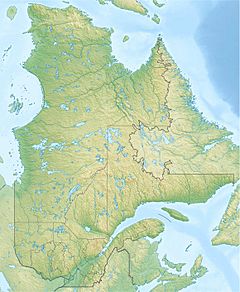Cugnet River facts for kids
Quick facts for kids Cugnet River |
|
|---|---|
| Native name | Rivière Cugnet |
| Country | Canada |
| Province | Quebec |
| Administrative region | Chaudière-Appalaches |
| RCM | Lotbinière Regional County Municipality |
| Physical characteristics | |
| Main source | Agricultural streams Saint-Lambert-de-Lauzon 143 metres (469 ft) 46°32′44″N 71°12′43″W / 46.545537°N 71.212042°W |
| River mouth | Beaurivage River Saint-Étienne-de-Lauzon 1,104 metres (3,622 ft) 46°35′34″N 71°21′26″W / 46.59278°N 71.35722°W |
| Length | 15.4 kilometres (9.6 mi) |
| Basin features | |
| Progression | Beaurivage River, Chaudière River, St. Lawrence |
| Tributaries |
|
The Cugnet River (in French: rivière Cugnet) is a river located in Quebec, Canada. It's like a smaller stream that feeds into a bigger river. The Cugnet River flows into the Beaurivage River. The Beaurivage River then joins the Chaudière River. Finally, the Chaudière River flows into the mighty Saint Lawrence River.
This river flows through two main areas. These are Saint-Lambert-de-Lauzon and Saint-Étienne-de-Lauzon. Both of these places are in the Chaudière-Appalaches region of Quebec.
Contents
River's Journey: Where it Flows
The Cugnet River is part of a larger system of waterways. Understanding its "watershed" helps us see how it connects to other rivers. A watershed is an area of land where all the water drains into a single river or lake.
Nearby River Systems
The Cugnet River shares its water with several nearby rivers. These are its main neighbors:
- North: The Beaurivage River and Chaudière River.
- East: The Chaudière River.
- South: Malbrook stream, Bras d'Henri, and the Beaurivage River.
- West: The rivière aux Pins, Noire River, rivière Rouge, and the Beaurivage River.
Where the Cugnet River Begins
The Cugnet River starts in Saint-Lambert-de-Lauzon. Its source is south of a road called "rue du Pont." This starting point is close to the town of Saint-Bernard. It's also about 1.2 kilometres (0.75 mi) west of the Chaudière River.
The River's Path
From its source, the Cugnet River travels about 15.4 kilometres (9.6 mi). It flows through areas with farms and forests. Here's how its journey is divided:
- First part: It flows north for 4.1 kilometres (2.5 mi). It crosses Route 218 along the way.
- Second part: It then turns west for 6.5 kilometres (4.0 mi). This section marks the border between Saint-Lambert-de-Lauzon and Saint-Étienne-de-Lauzon.
- Final part: The river continues westward for 4.8 kilometres (3.0 mi). This is its last stretch before it joins another river.
Where the Cugnet River Ends
The Cugnet River empties into the Beaurivage River. This happens on the eastern side of the Beaurivage River. The spot where they meet is called "Pointe Saint-Gilles."
This meeting point is special because:
- It's about 200 metres (660 ft) downstream from a bridge. This bridge connects the Lotbinière Regional County Municipality and the city of Lévis.
- It's also downstream from the village of Saint-Gilles.
- It's upstream from where the Noire River and Rouge River join the Beaurivage River.
Naming the River: The Story Behind "Cugnet"
The word "Cugnet" is a family name that comes from France. Rivers are often named after important people or features of the land.
Honoring François-Joseph Cugnet
The Cugnet River is named after François-Joseph Cugnet. He was a very important person in Quebec's history. He lived from 1720 to 1789. Cugnet was known for many different jobs and roles:
- He was a judge.
- He worked as an attorney general, which is a top legal advisor.
- He was a grand voyer, a person in charge of roads and bridges.
- He served as an official translator and French secretary for the governor of Quebec.
- He was also a lawyer.
François-Joseph Cugnet was born in Quebec on June 26, 1720. He was the oldest son of François-Étienne Cugnet and Louise-Madeleine Dusautoy. He passed away in Quebec on November 16, 1789.
The name "rivière Cugnet" was officially recognized on December 5, 1968. This was done by the Commission de toponymie du Québec, which is the group in charge of place names in Quebec.


